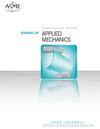镁纳米晶体拉伸、压缩和弯曲变形过程中取向效应的分子动力学模拟
IF 2.8
4区 工程技术
Q2 MECHANICS
引用次数: 48
摘要
采用分子动力学(MD)模拟研究了室温下镁纳米晶体在单轴拉伸、单轴压缩和纯弯曲过程中的变形模式。在每种加载条件下,通过将晶体c轴取向角θ相对于加载方向从0°增加到90°,增加15°来研究晶体取向效应。模拟结果表明,镁纳米晶体具有多种不同的变形模式和明显的拉压不对称性。当c轴远离拉伸加载方向旋转时,屈服变形模式由拉伸孪晶(θ≤45°)转变为压缩孪晶(θ > 45°)。压缩加载时,屈服仅受锥体(θ 60°)面位错滑移的支配。在单轴拉伸和单轴压缩载荷下,成核应力随θ的增大而减小。在纯弯曲模拟中,屈服主要受压缩侧和拉伸侧之间较弱的变形模式控制。当c轴偏离加载方向时,弯曲形核应力减小。本文章由计算机程序翻译,如有差异,请以英文原文为准。
Molecular Dynamics Simulations of Orientation Effects During Tension, Compression, and Bending Deformations of Magnesium Nanocrystals
The deformation modes in magnesium nanocrystals during uniaxial tension, uniaxial compression, and pure bending are investigated using molecular dynamics (MD) simulations at room temperature. For each loading condition, the crystal orientation effects are studied by increasing the crystal c-axis orientation angle θ relative to the loading direction from 0 deg to 90 deg by a 15 deg increment. The simulation results reveal a number of different deformation modes and an obvious tension–compression asymmetry in magnesium nanocrystals. As the c-axis is rotated away from the tension loading direction, the deformation mode at yielding changes from tension twinning (θ ≤ 45 deg) to compression twinning (θ > 45 deg). For compression loading, yielding is dominated by only dislocation slip on the pyramidal (θ 60 deg) planes. The nucleation stress in general decreases with increasing θ for both uniaxial tension and uniaxial compression loadings. For pure bending simulations, the yielding is mostly controlled by the weaker deformation mode between the compressive and tensile sides. The bending nucleation stress also decreases as the c-axis deviates away from the loading direction.
求助全文
通过发布文献求助,成功后即可免费获取论文全文。
去求助
来源期刊
CiteScore
4.80
自引率
3.80%
发文量
95
审稿时长
5.8 months
期刊介绍:
All areas of theoretical and applied mechanics including, but not limited to: Aerodynamics; Aeroelasticity; Biomechanics; Boundary layers; Composite materials; Computational mechanics; Constitutive modeling of materials; Dynamics; Elasticity; Experimental mechanics; Flow and fracture; Heat transport in fluid flows; Hydraulics; Impact; Internal flow; Mechanical properties of materials; Mechanics of shocks; Micromechanics; Nanomechanics; Plasticity; Stress analysis; Structures; Thermodynamics of materials and in flowing fluids; Thermo-mechanics; Turbulence; Vibration; Wave propagation

 求助内容:
求助内容: 应助结果提醒方式:
应助结果提醒方式:


